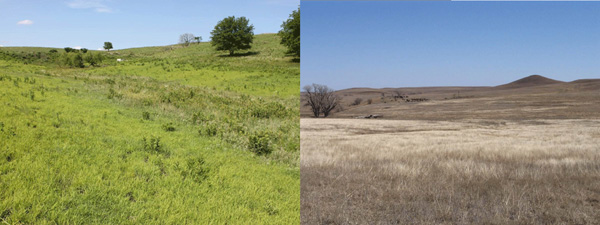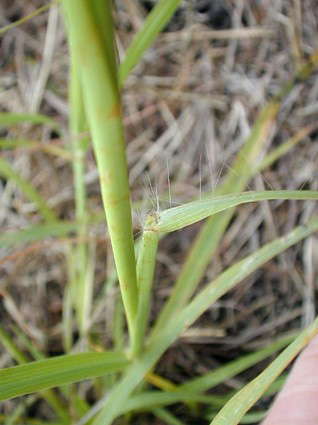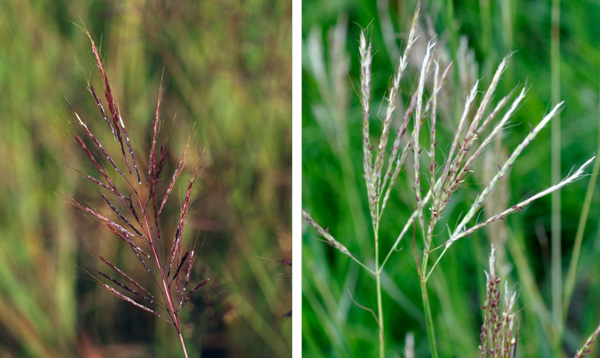Old World Bluestems (OWB) are the focus of this World of Weeds article. Two species commonly called OWB are Caucasian bluestem (Bothriochloa bladhii) and yellow bluestem (Bothriochloa ischaemum). There are several improved varieties of OWB, including King Ranch, Plains, WW B Dahl, WW Spar, and WW Iron Master bluestem. Even though they share the common name ‘bluestem,’ OWBs are not closely related to native bluestem species such as big bluestem, little bluestem, and broomsedge bluestem.
Ecology
Old world bluestems are warm-season perennial grasses native to Asia, Africa, and Australia. They were introduced into the U.S. for conservation purposes and as a forage crop for haying and grazing in the early 1900s, with seedings in Kansas probably occurring between the 1930s and 1960s. They are adapted to high calcareous and high pH soils and do well on any well-drained soil. They are very competitive with native species and are prolific seed producers. The invasive nature and relatively low palatability of quickly maturing OWBs allow them to increase once established.
Identification
Differentiating between OWB species without seedheads present is challenging because some vegetative characteristics are rather similar, with some range of variation within each species.
OWBs are bunch grasses, but yellow bluestem may eventually form a sod with continual heavy defoliation. They stand out in the landscape due to their light green color during the growing season and their light straw color when dormant (Figure 1). Leaves are thin (less than 0.25 inch) and pointed, up to 12 inches long, with sporadic long hairs at the base of the leaf (Figure 2). Leaf sheaths are hairless, and ligules are a hairy membrane.

Figure 1. Old World Bluestems have light green foliage (left) that turns straw-colored in the fall (right). Photos by Walt Fick, K-State Research and Extension.

Figure 2. Caucasian bluestem leaf hairs. Image by Mike Haddock, KSwildflower.org
Seed heads begin to emerge in mid-June to early July, which is earlier than many native species. Plants reach 1.5 to 3 feet in height by mid-summer. Nodes of Caucasian bluestem are purple-tinged and may have short hairs.
Inflorescences are typically 2.5 to 6 inches long. Yellow bluestem has 4 to 12 ‘fuzzy’ branches about the same length, arranged in a fan that originates toward the base of the seedhead. Caucasian bluestem has several more reddish-purple branches that get shorter toward the top of the seedhead (Figure 3).

Figure 3. Inflorescence of Caucasian bluestem (left) and Yellow bluestem (right). Images by Mike Haddock, KSwildflower.org
Management
Both glyphosate and imazapyr (Arsenal, others) can control OWB. Current recommendations include mowing or burning followed by a broadcast application of glyphosate (3 lb ae/A) or imazapyr (0.5 lb ae/A). Ideally, herbicides will be applied before an infestation is widespread, which would allow spot treatment with a 2.5% (5 pints/25 gal) glyphosate solution or 1% (2 pts/25 gal) imazapyr. Also, prescribed burns during the growing season (late July and August) with abundant fuel and slow-moving fires have been able to significantly reduce OWB in native stands.
Re-establishing desirable vegetation may be a challenge with either glyphosate or imazapyr. Native vegetation, especially many native tallgrasses, seems to be more tolerant of imazapyr, which may allow for the survival of many desirable plants if treating invading OWB stands.
The use of trade names is for clarity to readers and does not imply endorsement of a particular product, nor does exclusion imply non-approval. Always consult the herbicide label for the most current use requirements.
For more information on controlling Old World Bluestem, see the 2025 Chemical Weed Control for Field Crops, Pastures, Rangeland, and Noncropland, K-State publication SRP-1190.
Sarah Lancaster, Extension Weed Management Specialist
slancaster@ksu.edu
Keith Harmoney, Range Scientist - Hays
kharmone@ksu.edu
Tina Sullivan, Northeast Area Agronomist
tsullivan@ksu.edu